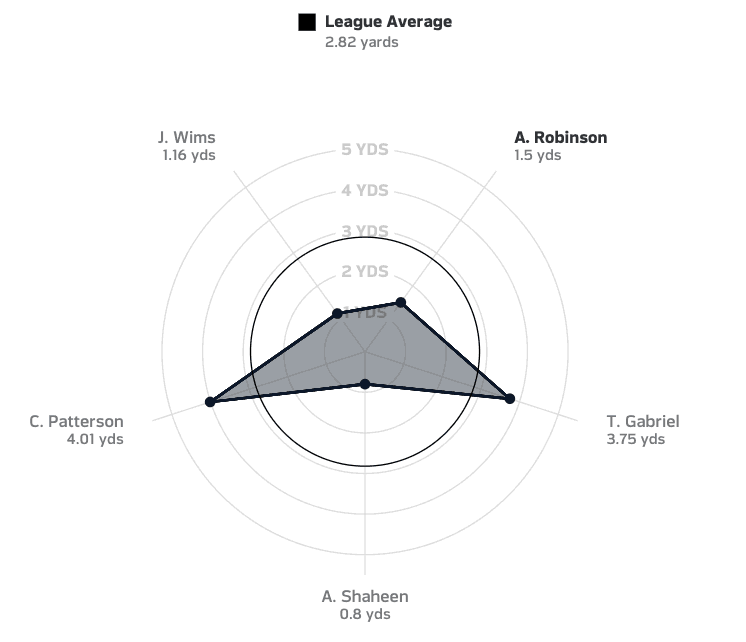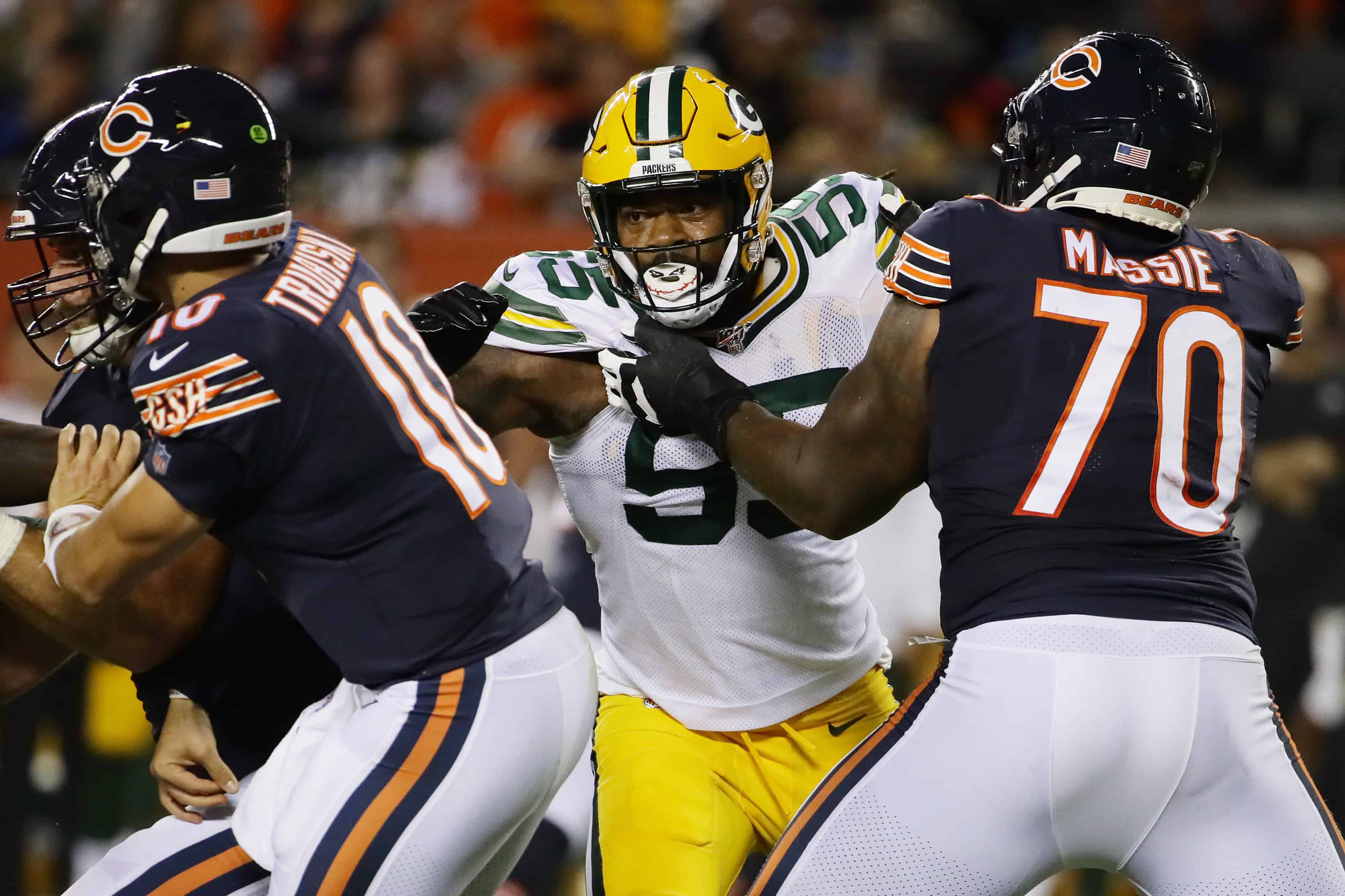All the focus heading into the Green Bay Packers’ Week 1 game against the Chicago Bears revolved around the fit between Aaron Rodgers and head coach Matt LaFleur. There might still be concerns about the offense — the lack of play-action (and points) is not a great first sign — but what stood out was what the Packers did on the other side of the ball.
Last season the Packers finished 29th in defensive DVOA and they were 20th in DVOA. But they kept on defensive coordinator Mike Pettine despite the head coaching change in the hope some health and another year of development in the same system could help the unit. Green Bay also went on a spending spree in free agency for more talent. Pass rusher Preston Smith and Za’Darius Smith were brought in as well as safety Adrian Amos. The Packers also went defense-heavy early in the draft with the selections of Rashan Gary and Darnell Savage. It’s only one game, but those investments look like they could pay off for a much better unit in 2019.
A New Pass Rush
With the additions of both Smiths, the Packers put a significant emphasis on the defensive line with the goal of being more disruptive. Last year’s Packers were fine at creating pressure and finished often enough — they 15th in pressure rate per Sports Info Solutions and 10th in Adjusted Sack Rate per Football Outsiders — but the personnel wasn’t enough to take over games. The production of leading pass rusher Kyler Fackrell also wasn’t likely to be repeated.
The investment paid off almost immediately. Green Bay as a team hit Mitchell Trubisky 11 times and came away with five sacks. Za’Darius Smith and Preston Smith each had three hits and combined for 3.5 sacks.
What really stood out with these two is not when they were rushing from opposite edges, but when Pettine put them on the same side of the line. This really came to life at the end of the game when the Packers needed a stop. On back-to-back plays at the end of the game, the two lined up on the same side of the line, gave the offensive line issues, and disrupted Trubisky.
The first play (on 3rd-and-8) saw Preston Smith (91) go wide around the corner and Za’Darius Smith (55) beat guard Cody Whitehair quickly to the inside to force pressure and a high throw.
On the next play, they added a stunt. Za’Darius Smith went to the outside shoulder of Whitehead and Preston Smith looped inside for a fourth-down sack that clinched the game for Green Bay.
Per Next Gen Stats, the Packers lined those two up on the same side 14 times and created pressure on seven of those plays. It’s an alignment that will be especially dangerous at the end of games or on third downs when opposing teams are forced to pass — two places Pettine has already been able to create pressure.
Last year’s Packers started slowly each game creating pressure, but picked it up in the second half. The problem was, Green Bay rarely had a lead and the pass rush was not as effective to the end result as it could have been had offenses been in a more pressing situation.
| Quarter | Pressure% | Rank |
|---|---|---|
| 1 | 27.27% | 19 |
| 2 | 30.81% | 19 |
| 3 | 36.43% | 2 |
| 4 | 35.17% | 8 |
data per Sports Info Solutions
One of the other benefits of having players of that caliber is the ability to move them around and create mismatches. Per Next Gen Stats, Za’Darius Smith created five of his seven pressures lined up on the interior, rather than the edge. This can allow the Packers to pick on a weak link. (The Bears also did this by getting Khalil Mack or Akiem Hicks matched up against guard Billy Turner).
Za'Darius Smith generated 5 of his 7 pressures aligned as a interior DL, despite aligning as an edge defender on the majority of his pass rushes.
As a member of Ravens last season, Smith was more effective generating pressure from the interior (12.3%) than the edge (9.5%). https://t.co/esfsfcBYSG
— Next Gen Stats (@NextGenStats) September 6, 2019
The Chicago offense had its problems on Thursday night and last season, but the offensive line hadn’t been one of those issues. In 2018, the Bears finished sixth as a team in ESPN’s Pass Block Win Rate and eighth in offensive pressure rate allowed. Consistently creating and capitalizing on pressure against this offensive line is a positive indicator for this pass rush going forward.
No Separation
Even when Mitchell Trubisky wasn’t under pressure on Thursday, he had nowhere to go with the ball. Per Next Gen Stats, Trubisky threw into tight coverage — defined as a yard or fewer of separation — on 26.7% of his passes. In an era when the league’s best offenses are figuring out how to avoid tight windows, the Bears quarterback didn’t really have a choice.
There were some plays where Allen Robinson was open and Trubisky didn’t see him, but for the most part there wasn’t a lot of opening in the passing game. On his 13 targets, Robinson only averaged 1.5 yards of separation. For some context, last year Kelvin Benjamin had the worst rate of separation in the league at 1.7 yards.

The Green Bay defense also combined for nine passes defensed, a number of which should have been interceptions.
A Modern Alignment
We know defensive personnel is typically controlled by the personnel used by the offense. However, Green Bay might be a team that knows what works, what it wants to do, and sticks with it. Last year the Packers only used “base” defense on 18% of defensive snaps, which ranked 24th in the league. They used nickel 40% of the time, which only ranked 28th, but they used dime or more for 41% of their defensive snaps, which ranked second.
The Packers looked to be a team that was going to be defensive back heavy and that’s what they did against the Bears. Chicago varied formations with multiple backs and tight ends but the Packers stuck with at least a nickel package to defend against them. They did this while not giving up much leverage on the ground against the run.
Matching 12p with nickel >>>>>> pic.twitter.com/KT5B2B8yQi
— Steven Ruiz (@theStevenRuiz) September 6, 2019
Per nflscrapR data, the Bears averaged just minus-0.34 Expected Points Added per rushing attempt with a success rate of 29%. That was all done while defending the pass first and holding the Bears to minus-0.32 EPA per attempt through the air with a 32% success rate.
Green Bay didn’t really have a second inside linebacker play often next to Blake Martinez, who was on the field for 100% of the defensive snaps. Safeties Adrian Amos and Darnell Savage also played 100% of the snaps and were joined by a third safety, Raven Greene on 77% of the snaps. Other defensive backs like Kevin King (58%) and Tony Brown (37%) mixed in alongside Jaire Alexander and Tramon Williams, who did not leave the field.
Going Forward
It’s too early to say this Packers defense is going to be one of the dominant units of 2019, but the early signs were encouraging. The defense also doesn’t have to be a top-10 or top-5 unit to be a useful part of the team. What can make a difference, though, is if the defense can stay hot in the early part of the season as the offense clearly still needs some time to settle in. It’s possible once the offense catches on, the defense can be even more dangerous protecting late leads.
Time will tell if this can continue, but Thursday night was already one of the best defensive performances the Packers have put on in quite some time.
















